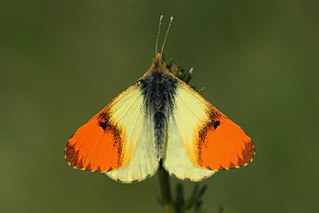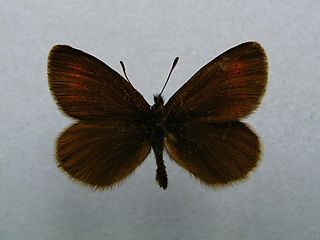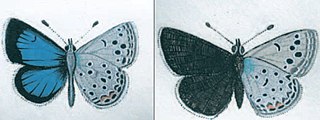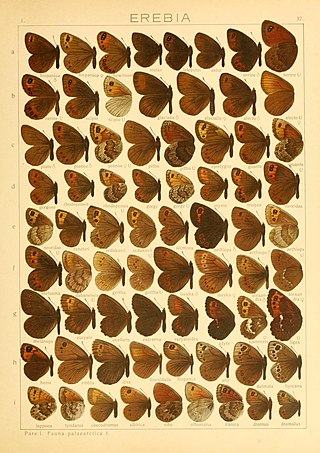
Anthocharis damone, the eastern orange tip, is a butterfly in the subfamily Pierinae, found in southern Europe and into Asia Minor.

Melitaea diamina, the false heath fritillary, is a butterfly of the family Nymphalidae.

Parnassius stubbendorfi is a high-altitude butterfly found in from the Altai Mountains across central, south, and far east Siberia, Sakhalin and the Kuril Islands and from Mongolia across north China to west Korea and Japan (Hokkaido). It is a member of the snow Apollo genus (Parnassius) of the swallowtail family (Papilionidae).

The bright eyed ringlet is a member of the Satyridae subfamily of Nymphalidae. It is a high mountain butterfly found in the Pyrenees, Massif Central, Alps and Balkan mountains. It has recently been confirmed to occur in the southern chain of the Carpathians.

The Eriphyle ringlet is a member of the subfamily Satyrinae of family Nymphalidae. It is a high mountain butterfly found in the Alps.Wheeler (1903) gives a short description

Mythimna albipuncta, the white-point, is a moth of the family Noctuidae. The species was first described by Michael Denis and Ignaz Schiffermüller in 1775. It is distributed throughout Europe and one subspecies is found in Tunisia. It is also found in Asia Minor, Armenia, and Iran, and the northeastern United States.

Periphanes is a monotypic moth genus of the family Noctuidae first described by Jacob Hübner in 1821. Its only species, Periphanes delphinii, the pease blossom, was first described by Carl Linnaeus in his 1758 10th edition of Systema Naturae. It can be found from Afghanistan and the steppe areas of Central Asia and Anatolia up to the area surrounding the Mediterranean Sea and north-western Africa.

Chazara briseis, the hermit, is a butterfly species belonging to the family Nymphalidae. It can be found in North Africa, southern Europe, Asia Minor, the Caucasus, Kazakhstan, Central Asia through Afghanistan, and north-western China and Tuva. It is found on steppe and in other dry grassy places between 500 and 2,500 meters.

Chersotis margaritacea is a moth of the family Noctuidae. It is found in Central and Southern Europe up to heights of 1,500 meters. Outside of Europe, it is found in Algeria, Morocco, Anatolia, Iran, Georgia, Armenia, Kazakhstan up to the Altai Mountains.

Boloria pales, the shepherd's fritillary, is a butterfly of the family Nymphalidae. It is found from the Cantabrian Mountains and the Pyrenees through the Alps and Apennine Mountains east to the Balkan, Carpathian Mountains, the Caucasus and central Asia up to western China.

Muschampia proto, the sage skipper, is a butterfly of the family Hesperiidae. It is found in Morocco, Algeria, the Iberian Peninsula and southern France.

Muschampia tessellum, the tessellated skipper, is a butterfly of the family Hesperiidae. It is found from the southern Balkan Peninsula through Ukraine, southern Russia and Asia Minor, southern Siberia, Mongolia, east to the Amur region.

Chazara persephone, the dark rockbrown, is a butterfly species belonging to the family Nymphalidae. It can be found from Crimea across the Caucasus and north of the Middle East to Iran; from the southern Urals across Kazakhstan to the southern Altai and west Siberia.

Arethusana is a butterfly genus from the subfamily Satyrinae of the brush-footed butterfly family (Nymphalidae). It is composed of only one species, Arethusana arethusa, the false grayling.

Graphium bathycles, the veined jay, is a butterfly in the family Papilionidae, that is found in the Indomalayan realm.

Turanana endymion, the odd-spot blue or Anatolian odd-spot blue, is a butterfly of the family Lycaenidae. It was described by Christian Friedrich Freyer in 1850. It is found in Turkey, Lebanon and Iran. Records from Europe refer to Turanana taygetica.

Tomares nogelii is a small butterfly found in the Palearctic that belongs to the blues family.

Proterebia afra is a small butterfly found in the Palearctic that belongs to the browns family.

Erebia maurisius is a butterfly found in the East Palearctic that belongs to the browns family.

Polyommatus damone is a Palearctic butterfly in the Lycaenidae family.




















